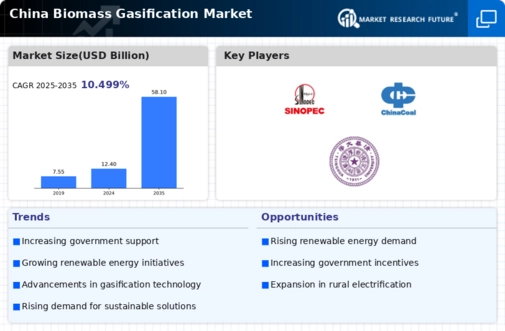Rising Energy Demand
The increasing energy demand in China is a pivotal driver for the biomass gasification market. As the nation continues to industrialize and urbanize, the need for sustainable energy sources becomes more pressing. In 2025, China's energy consumption is projected to rise by approximately 3.5% annually. This surge in demand necessitates alternative energy solutions, with biomass gasification emerging as a viable option. The technology not only provides a renewable energy source but also helps in reducing reliance on fossil fuels. Furthermore, the biomass gasification market is expected to play a crucial role in meeting the energy needs of rural areas, where traditional energy infrastructure may be lacking. This growing demand for energy, coupled with the push for cleaner technologies, positions the biomass gasification market as a key player in China's energy landscape.
Environmental Regulations and Compliance
Stringent environmental regulations in China are propelling the biomass gasification market forward. The government has established strict emissions standards to combat air pollution and promote cleaner energy solutions. In 2025, compliance with these regulations is becoming increasingly critical for energy producers. Biomass gasification offers a pathway to meet these standards by converting waste materials into clean energy while minimizing greenhouse gas emissions. The market is likely to benefit from the growing emphasis on sustainable practices, as companies seek to align their operations with environmental policies. This regulatory pressure not only drives innovation in biomass technologies but also enhances the market's attractiveness to investors looking for sustainable energy solutions. Consequently, the biomass gasification market is positioned to thrive in an environment that prioritizes ecological responsibility.
Government Incentives for Renewable Energy
The Chinese government has implemented various incentives to promote renewable energy, significantly impacting the biomass gasification market. Policies such as feed-in tariffs and subsidies for biomass projects encourage investment in this sector. In 2025, the government aims to increase the share of renewable energy in the national energy mix to 20%, with biomass gasification being a critical component. These incentives not only lower the financial barriers for new projects but also stimulate research and development in biomass technologies. As a result, the biomass gasification market is likely to experience accelerated growth, attracting both domestic and foreign investments. The supportive regulatory environment fosters innovation and enhances the competitiveness of biomass gasification solutions, making them more appealing to energy producers and consumers alike.
Growing Awareness of Waste Management Solutions
The rising awareness of waste management issues in China is significantly influencing the biomass gasification market. As urbanization accelerates, the volume of agricultural and municipal waste continues to increase, creating a pressing need for effective waste management strategies. Biomass gasification presents a sustainable solution by converting waste into valuable energy, thereby addressing both energy and waste disposal challenges. In 2025, the market is expected to see a surge in projects aimed at utilizing waste biomass for energy production. This dual benefit of waste reduction and energy generation is likely to attract investments and partnerships between municipalities and energy companies. The biomass gasification market is thus positioned to play a crucial role in China's efforts to develop a circular economy, where waste is minimized, and resources are efficiently utilized.
Technological Innovations in Biomass Processing
Technological advancements in biomass processing are driving the growth of the biomass gasification market in China. Innovations such as improved gasification technologies and efficient feedstock conversion methods enhance the overall efficiency and cost-effectiveness of biomass gasification systems. In 2025, the market is witnessing a shift towards integrated biomass gasification systems that combine multiple processes for optimal energy output. These innovations not only increase the yield of syngas but also reduce emissions, aligning with China's environmental goals. The adoption of advanced technologies is expected to lower operational costs, making biomass gasification more competitive against traditional energy sources. As a result, the biomass gasification market is likely to attract more stakeholders, including energy companies and research institutions, eager to capitalize on these technological advancements.














Leave a Comment